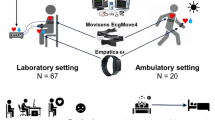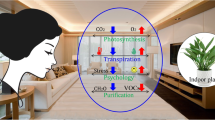Abstract
Gender difference in thermal comfort for Chinese people was investigated through two laboratory experiments. Both subjective assessment and objective measurement were taken during the experiment. Skin temperature (17 points) and heart rate variability (HRV) were measured in one of the experiment. Our results show that there are gender differences in thermal comfort for Chinese people. Correlation of thermal sensation votes and air temperature and vapor pressure shows that females are more sensitive to temperature and less sensitive to humidity than males. Subjective assessment, skin temperature and HRV analysis suggest that females prefer neutral or slightly warmer condition, due to their constantly lower skin temperature and the fact that mean skin temperature is a good predictor of sensation and discomfort below neutrality. Female comfortable operative temperature (26.3°C) is higher than male comfortable operative temperature (25.3°C), although males and females have almost the same neutral temperature and that there is no gender difference in thermal sensation near neutral conditions.








Similar content being viewed by others
References
ASHRAE (2005) ASHRAE fundamentals handbook––thermal comfort. American Society of Heating, refrigerating, and Air-Conditioning Engineers, Atlanta
Avellini BA, Kamon E (1980) Physiological responses of physically fit men and women to acclimation to humid heat. J Appl Physiol 49:254–261
Bigger JT, Fleiss LF, Steinman RC, Rolnitzsky LM, Scheider WJ, Stein PK (1995) RR variability in healthy, middle-age persons compared with patients with chronic coronary heart disease or recent acute myocardial infarction. Circulation 91:1936–1943
Cena K, de Dear RJ (1999) Field study of occupant comfort and office thermal environments in a hot, arid climate. ASHRAE Trans 105:204–217
de Dear RJ, Fountain ME (1994) Field experiments on occupant comfort and office thermal environments in a hot-humid climate. ASHRAE Trans 100:457–475
Donnini G, Dorothy HC, Laflamme M, Molina J, Lai HK, Nquyen VN, Martelo C, Chang CY, Haqhiqhat F (1997) Field study of occupant comfort and office thermal environments in a cold climate. ASHRAE Trans 103:205–220
Ellis FP (1953) Thermal comfort in warm, humid atmospheres: observations in a warship in the tropics. J Hyg 50:415–432
Federspiel CC (1998) Statistical analysis of unsolicited thermal sensation complaints in commercial buildings. ASHRAE Trans 104:912–923
Fishman DS, Pimbert SL (1979) Survery of the subjective responses to the thermal environment in offices. In: Fanger PO, Valbjorn O (eds) Indoor climate, vol 99. Danish Building Research Institute, Copenhagen, pp 677–698
Gagge AP, Stolwilk JA, Hardy JD (1967) Comfort and thermal sensations and associated physiological responses at various ambient temperatures. Environ Res 1:1–20
Grivel F (1991) Ambient temperatures preferred by young European males and females at rest. Ergonomics 34:365–378
Hainsworth R (1995) The control and physiological importance of heart rate. In: Malik M, Camm AJ (eds) Heart rate variability, Futura Publishing, Armonk
Hwang RL, Lin TP, Kuo NJ (2006) Field experiments on thermal comfort in campus classrooms in Taiwan. Energy Build 38:53–62
Iwasea S, Ikeda T, Kitazawa H, Hakusui S, Sugenoya J, Mano T (1997) Altered response in cutaneous sympathetic outflow to mental and thermal stimuli in primary palmoplantar hyperhidrosis. J Auton Nerv Syst 64:65–73
Junta Nakano, Shin-ichi Tanabe, Ken-ichi Kimura (2002) Differences in perception of indoor environments between Japanese and non-Japanese workers. Energy Build 34:615–621
Karjalainen S (2007) Gender differences in thermal comfort and use of thermostats in everyday thermal environments. Build Environ 42:1594–1603
Lu GW (2000) Medical neurobiology. Higher Education Press, Beijing
Malliani A, Pagani M, Lombardi F, Cerutti S (1991) Cardiovascular neural regulation explored in the frequency domain. Circulation 84:482–491
McIntyre DA (1980) Indoor Climate. Applied Science Publishers, London
Modera MP (1993) Skin temperature and evaporative heat loss variations for men and women in thermal comfort. ASHRAE Trans 99:210–222
Mohr E, Langbein J, Nurnberg G (2002) Heart rate variability a noninvasive approach to measure stress in calves and cows. Physiol Behav 75:251–259
Ouyang Y (1985) Clothing Hygiene. People’ Military Medical Press, Beijing
Pagani M, Lombardi F, Guzzetti S, Rimoldi O, Furlan R, Pizzinelli P (1986) Power spectral analysis of heart rate and arterial pressure variabilities as a marker of sympatho-vagal interaction in man and conscious dog. Circ Res 59:178–193
Parsons KC (2002) The effects of gender, acclimation state, the opportunity to adjust clothing and physical disability on requirements for thermal comfort. Energy Build 34:593–599
Pomeranz B, Macaulay RJB, Caudill MA, Kutz I, Adam D, Gordon D (1985) Assessment of autonomic function in humans by heart rate spectral analysis. Am J Physiol 248:H151–H153 (Heart Circ Physiol, 17)
Sawasaki N, Iwasea S, Manoa T (2001) Effect of skin sympathetic response to local or systemic cold exposure on thermoregulatory functions in humans. Auton Neurosci 87:274–281
Stein PK, Kleiger RE, Rottman JN (1997) Differing effects of age on heart rate variability in men and women. Am J Cardiol 80:302–305
Acknowledgments
This work was supported by National Natural Science Foundation of China under the contract of No.50478018. The authors also would like to thank the occupants for their excellent cooperate in this survey and experiment.
Author information
Authors and Affiliations
Corresponding author
Rights and permissions
About this article
Cite this article
Lan, L., Lian, Z., Liu, W. et al. Investigation of gender difference in thermal comfort for Chinese people. Eur J Appl Physiol 102, 471–480 (2008). https://doi.org/10.1007/s00421-007-0609-2
Accepted:
Published:
Issue Date:
DOI: https://doi.org/10.1007/s00421-007-0609-2




